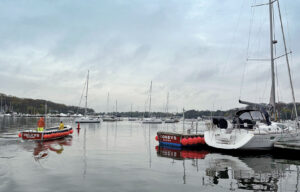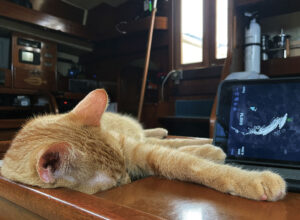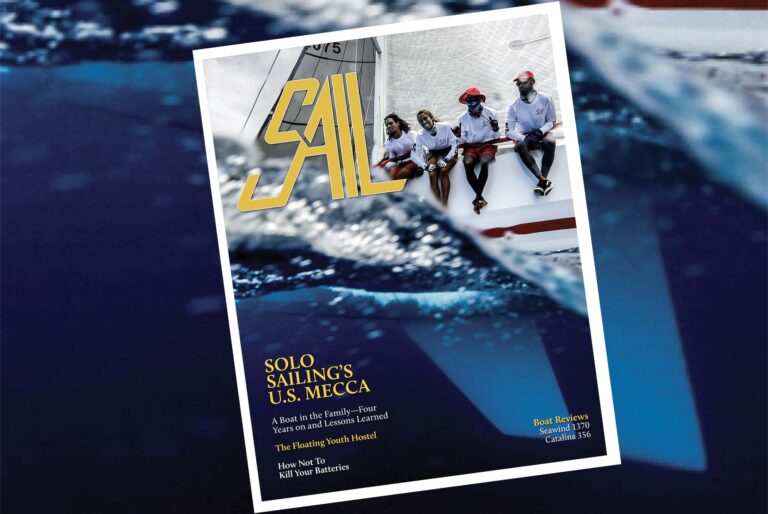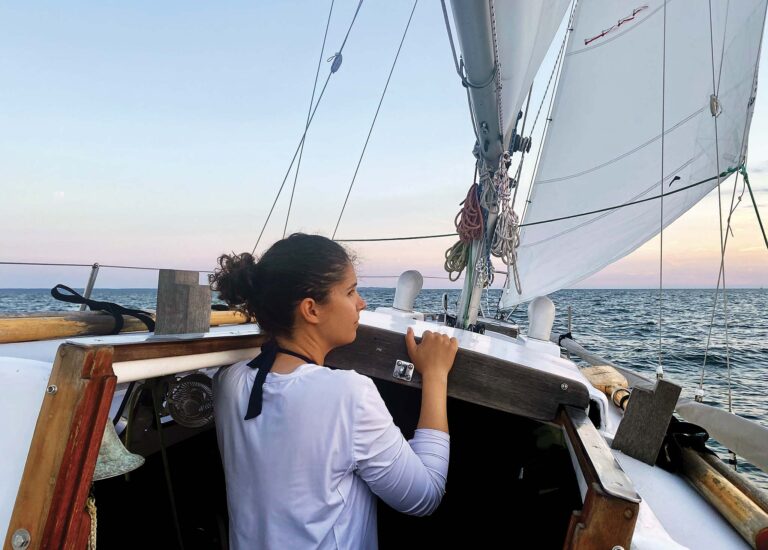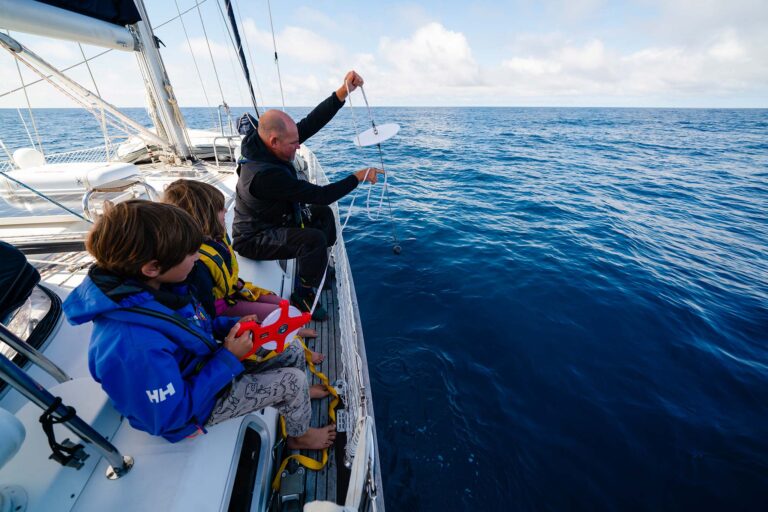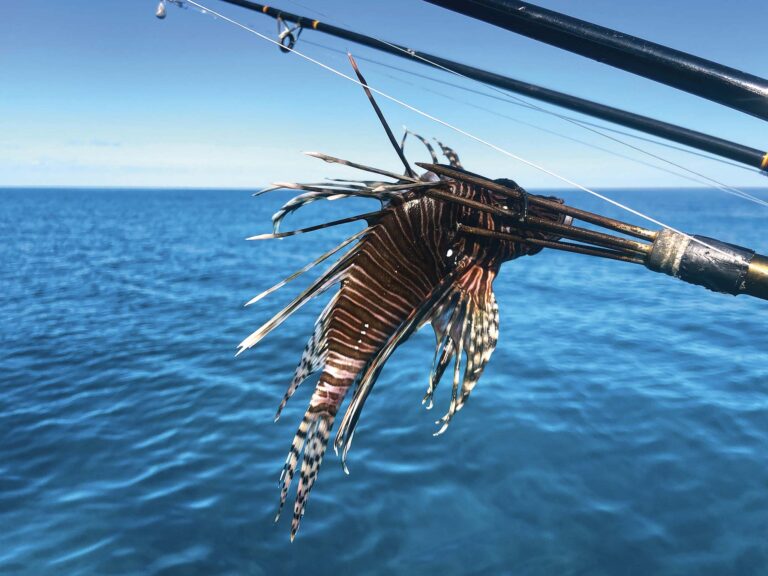
The Bahamas is a vast country consisting of over 700 islands spread out over an area 25 percent larger than New England. Attracted by year-round sunshine, the lure of excellent fishing, world-class diving and calm waters, thousands of boaters of all ages and nationalities visit the Bahamas each year. For many, it is their first foray into the laid-back island lifestyle romanticized by Ernest Hemingway’s Islands in the Stream and the melodies of Jimmy Buffett.
With all the good the islands have to offer, it is an immutable law of nature that from June 1 to November 30 every year, the country is subject to the ravages of tropical storms and hurricanes. When asked about the weather threat, most Bahamians take it in stride and rightly focus on the vast majority of days when the water is clear and the sky is blue. It is therefore not a coincidence that upon independence from Great Britain in 1973 the country chose the colors Blue, Yellow and Black for their national flag to signify the sea, the sun and the strength of its people.

When Hurricane Dorian started life as a patch of rain clouds off the coast of Africa, few Bahamians took notice. Tropical systems are notoriously fickle and as the system drifted westward even the early indications that a Category 3 major hurricane was possible did not raise major concerns. Initially, it appeared that the Leeward Islands or Puerto Rico, still reeling from the effects of Maria, would once again draw the short straw. It was not until the storm called Dorian passed Puerto Rico and headed back into the warm waters of the western Atlantic that it became apparent that it would visit the Bahamas.
Every prudent sailor in the tropics has a hurricane plan. It may not be the formalized written plan that is rapidly becoming a requirement of many insurers, but no sane captain wants to be the unicorn dancing in the rain as the ark pulls away. For some the plan is simple—get out of the way or get off the water to fight another day. For others, the plan is more nuanced, with actions tied to the weather forecast. Fortunately, plans are seldom tested, as tropical weather affects a limited area each year and sailors can go through an entire lifetime without experiencing a direct hit from a major hurricane.
As the path of Dorian became more certain, the residents, boaters and charter companies in the Abacos and Grand Bahama began to prepare for the approaching storm. The most cautious—and, in hindsight, the most prescient—left the area immediately. Others, hardened by past storms or perhaps in denial that the worst could happen, decided to stay and deploy their hurricane plans. By the time the storm had intensified to a Category 4 hurricane, it was becoming obvious that without a last-minute reprieve the worst could no longer be denied and was likely to become reality.
These photographs of the Conch Inn at Marsh Harbour before and after the storm are evidence of Dorian’s extreme destructive power
On September 1, after winding its way across the tropical south Atlantic Ocean, and brushing the Leeward Islands and Puerto Rico, Hurricane Dorian made landfall on Elbow Cay in the northern Bahamas as a deadly Category 5 storm. With sustained wind speeds reaching 185mph and gusting to over 200mph, it made nonsense of almost every hurricane plan.
Unlike past storms that moved steadily along a path, Hurricane Dorian slowed to hover over Abaco and nearby Grand Bahama Island for two days. The destructive energy that was blasted on the area, according to U.S. National Hurricane Center scientist Chris Landsea, was equivalent to several times the total daily electric power generation for the entire world.
During an interview with a local TV station, James Albury, a lifelong resident of Man-O-War Cay, recounted: “When we had Hurricane Floyd we experienced winds of 231mph and the only thing that was lost on the houses was the shingles, but this was a completely different thing. This was all tornadoes. If you look around, 98 percent of the roofs in Man-O-War is half gone.”
Structures that were built to withstand 200mph winds were no match for the 25ft-high wall of storm surge water that accompanied the winds. What was not blown apart by the wind was washed away by the sea. The shanty towns on the mainland of Greater Abaco did not have a chance, as heavy flooding rose above the rooftops in minutes.
Perry Smith, an American sailor who is currently working in Afghanistan and is no stranger to harsh conditions, evacuated his wife and remained behind to look after their boat in Marsh Harbour. He describes emerging from a storm shelter as the eye of the storm passed over him. “What we saw was tragic. The entire neighborhood looked like a war zone. Every house was either destroyed or very heavily damaged. The transformation in just a couple of hours was so dramatic it was hard to recognize.”
Smith’s 44ft sailboat, which he prepared for the storm by tying it diagonally in a slip at the Marsh Harbour Marina, was destroyed when the marina docks failed. It eventually ended up several miles away in a field.
The Moorings, the largest bareboat charter company in The Bahamas, is well experienced with hurricanes. The company prepared for the storm by evacuating all its guests and all but essential staff from its base in Marsh Harbour. Much of the fleet was moved to the company’s Nassau base and what was left was taken into nearby mangrove canals. As the storm passed everything sheltered nearby was lost, and the Conch Inn Marina where the boats are normally docked was obliterated.
Similar stories of devastation and destruction were repeated for every area in the storm’s path. For the people in Green Turtle Cay, Hopetown, Man-O-War, Great Guana, Treasure Cay, Freeport Grand Bahama, life as they knew it changed forever. A sentiment echoed by survivors, many of whom are still struggling with post-traumatic stress disorder, is both sobering and chilling in its simplicity; “I am not ready to tell my story.”
As the storm raged, native Bahamians and foreigners who had adopted the Bahamas as their destination of choice rallied to help. Steered by a moral compass and powered by their desire to help neighbors in need, grassroots relief efforts sprang up overnight to get first responders and aid into the affected areas. Selflessly and quickly, the world stepped up to help.
Ed Strobel, an experienced Bahamas boater and pilot who lives in Fort Lauderdale, was preparing his own home and boat for a possible direct hit from Dorian. When Abaco came into the crosshairs of the storm, he contacted friends and neighbors to coordinate a relief team. According to Strobel, “Within hours Hope4Hopetown was born and by day’s end we had a Facebook presence, website and a list of volunteers pledging cash, supplies, boats and airplanes.” Many of the first post-Dorian photographs of the affected areas came from reconnaissance flights conducted by Hope4Hopetown pilots.
Overnight, an impromptu flotilla of commercial fishing boats from Spanish Wells, harbor ferries from Nassau and private yachts from around the world delivered everything from diapers to chainsaws as they conducted a Dunkirk-style evacuation of affected people who wanted out of the area. Thousands were moved by sea and, once the floodwaters receded from the airports, by air to either shelters in other parts of the Bahamas or to the homes of friends and relatives. Private helicopters were pressed into service to deliver food to first responders and cruise ships changed their routes so they could serve meals to survivors.
Pilot Ed Strobel organized early relief efforts
Roston McGregor advises that self-sufficiency means bringing in everything you need, from water to fuel, for the duration of your stay.
Perry Smith’s 44ft sailboat, which he prepared for the storm by tying it diagonally in a slip at the Marsh Harbour Marina, was destroyed when the marina docks failed.
As a testament to the relief effort and the strength of the Bahamian people, within a month of the storm makeshift schools were opening. The cellphone network had been largely restored, which in the days following the storm proved to be a lifeline for many. Electricity is being generated, although the power lines leading into devastated communities continue to be a work in progress. It will be years before the worst-hit areas become normal, but the work continues and life goes on.
In the areas of the Bahamas not directly affected by the storm, preparations are well underway to greet visitors from around the world. Peter Maury, the president of the Association of Bahamas Marinas, notes that it will be some time before the marinas around the Sea of Abaco are operating, but other member marinas are open. Maury’s advice for those wishing to secure a slip in a marina is to call ahead and book as soon as possible, as they anticipate a busy season as traffic diverts to those who are open.
Maury’s optimism is well-founded, because the path of Dorian over the Sea of Abaco and the Little Bahama Bank left most of the country untouched. South of the North West Providence Channel, the 50-mile-wide body of ocean that divides the Little Bahama Bank from the rest of the country, it is business as usual. Even on Grand Bahama Island, many south coast marinas are open. Nina Dormans, the general manager of the Ocean Reef Yacht Club in Lucaya Grand Bahama, seemed surprised that she was being asked about her post-Dorian Plans. “We suffered very minor damage with a piling on one of our slips pulled out by a boat that had been tied too tightly. Otherwise, our reservation book is full and we are turning away new reservations,” she said.
With this in mind, many sailors who consider Abaco synonymous with the Bahamas have merely adjusted their plans to sail further south. Canadian Ed Radonic, for example, who normally keeps his boat in Man-O-War Cay, advises that he will be returning to the Abacos with a boatload of donated supplies and then heading down toward the Exumas to resume his charter boat business. Other than that, Radonic said he expects business as usual.
As for sailors who are completely self-sufficient, there is an ongoing need for volunteers to help with the rebuilding of the communities in the Abacos. Roston McGregor, a salvage operator who has been working non-stop moving vessels affected by the storm, advises that self-sufficiency means bringing in everything you need, from water to fuel, for the duration of your stay. It is also important to coordinate with the community to ensure that the appropriate duty and VAT exemptions are issued for relief supplies. Nothing can be taken for granted in the affected areas.

Tourism is the lifeblood of the Bahamas and any boater can contribute to the relief effort by simply visiting the country. The money that is brought in will go a long way to rebuilding the affected communities. Despite the horrific images in the press, much of the Bahamas was unaffected by the storm and virtually everyone who was contacted for this article wants the world to know that the Bahamas is open for business.
January 2020










